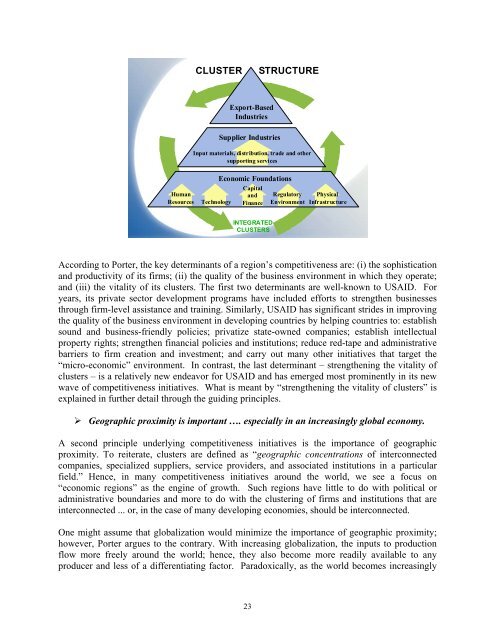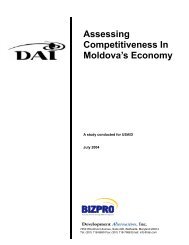Promoting Competitiveness in Practice - Economic Growth - usaid
Promoting Competitiveness in Practice - Economic Growth - usaid
Promoting Competitiveness in Practice - Economic Growth - usaid
Create successful ePaper yourself
Turn your PDF publications into a flip-book with our unique Google optimized e-Paper software.
Human<br />
Resources<br />
CLUSTER STRUCTURE<br />
Export-Based<br />
Industries<br />
Supplier Industries<br />
Input materials, distribution, trade and other<br />
support<strong>in</strong>g services<br />
Technology<br />
<strong>Economic</strong> Foundations<br />
Capital<br />
and<br />
F<strong>in</strong>ance<br />
INTEGRATED<br />
CLUSTERS<br />
Regulatory<br />
Environment<br />
Physical<br />
Infrastructure<br />
Accord<strong>in</strong>g to Porter, the key determ<strong>in</strong>ants of a region’s competitiveness are: (i) the sophistication<br />
and productivity of its firms; (ii) the quality of the bus<strong>in</strong>ess environment <strong>in</strong> which they operate;<br />
and (iii) the vitality of its clusters. The first two determ<strong>in</strong>ants are well-known to USAID. For<br />
years, its private sector development programs have <strong>in</strong>cluded efforts to strengthen bus<strong>in</strong>esses<br />
through firm-level assistance and tra<strong>in</strong><strong>in</strong>g. Similarly, USAID has significant strides <strong>in</strong> improv<strong>in</strong>g<br />
the quality of the bus<strong>in</strong>ess environment <strong>in</strong> develop<strong>in</strong>g countries by help<strong>in</strong>g countries to: establish<br />
sound and bus<strong>in</strong>ess-friendly policies; privatize state-owned companies; establish <strong>in</strong>tellectual<br />
property rights; strengthen f<strong>in</strong>ancial policies and <strong>in</strong>stitutions; reduce red-tape and adm<strong>in</strong>istrative<br />
barriers to firm creation and <strong>in</strong>vestment; and carry out many other <strong>in</strong>itiatives that target the<br />
“micro-economic” environment. In contrast, the last determ<strong>in</strong>ant – strengthen<strong>in</strong>g the vitality of<br />
clusters – is a relatively new endeavor for USAID and has emerged most prom<strong>in</strong>ently <strong>in</strong> its new<br />
wave of competitiveness <strong>in</strong>itiatives. What is meant by “strengthen<strong>in</strong>g the vitality of clusters” is<br />
expla<strong>in</strong>ed <strong>in</strong> further detail through the guid<strong>in</strong>g pr<strong>in</strong>ciples.<br />
Geographic proximity is important …. especially <strong>in</strong> an <strong>in</strong>creas<strong>in</strong>gly global economy.<br />
A second pr<strong>in</strong>ciple underly<strong>in</strong>g competitiveness <strong>in</strong>itiatives is the importance of geographic<br />
proximity. To reiterate, clusters are def<strong>in</strong>ed as “geographic concentrations of <strong>in</strong>terconnected<br />
companies, specialized suppliers, service providers, and associated <strong>in</strong>stitutions <strong>in</strong> a particular<br />
field.” Hence, <strong>in</strong> many competitiveness <strong>in</strong>itiatives around the world, we see a focus on<br />
“economic regions” as the eng<strong>in</strong>e of growth. Such regions have little to do with political or<br />
adm<strong>in</strong>istrative boundaries and more to do with the cluster<strong>in</strong>g of firms and <strong>in</strong>stitutions that are<br />
<strong>in</strong>terconnected ... or, <strong>in</strong> the case of many develop<strong>in</strong>g economies, should be <strong>in</strong>terconnected.<br />
One might assume that globalization would m<strong>in</strong>imize the importance of geographic proximity;<br />
however, Porter argues to the contrary. With <strong>in</strong>creas<strong>in</strong>g globalization, the <strong>in</strong>puts to production<br />
flow more freely around the world; hence, they also become more readily available to any<br />
producer and less of a differentiat<strong>in</strong>g factor. Paradoxically, as the world becomes <strong>in</strong>creas<strong>in</strong>gly<br />
23
















